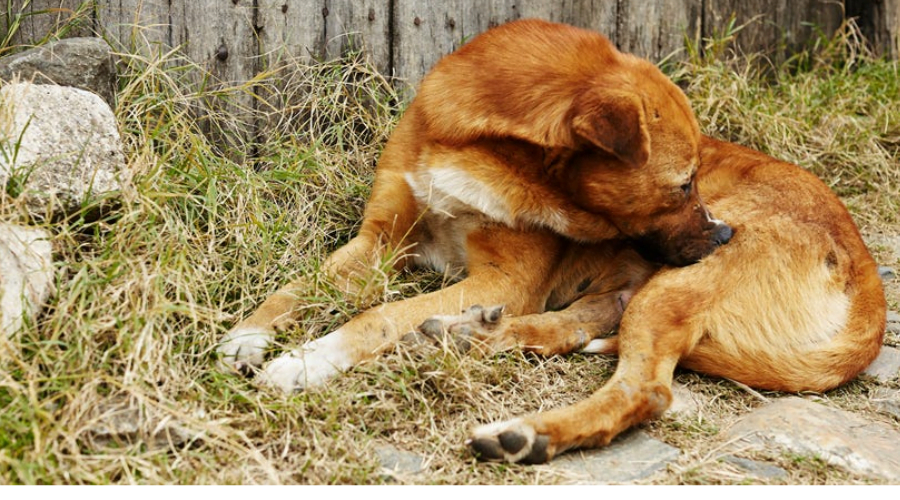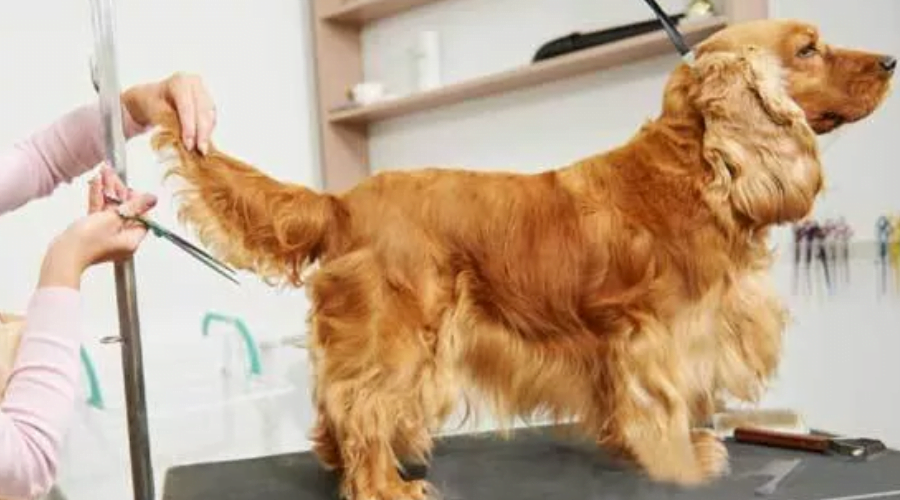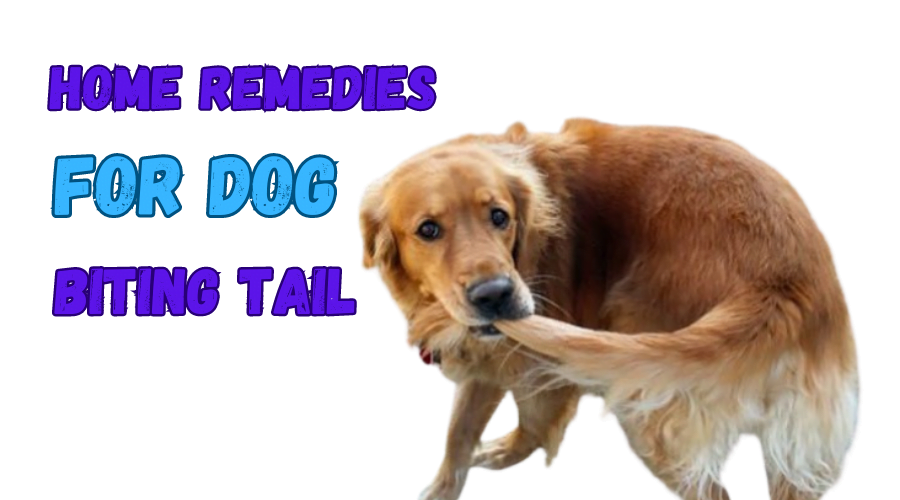Does your dog keep biting their tail? You are not able to enjoy your favorite TV show because of this problem? You’re not alone. Many dog owners face this issue. But, there’s good news! There are a bunch of easy home remedies that can help you to treat this problem.
As a dog owner, it can be disturbing to see your dog every time biting their tail. You may feel helpless, not knowing how to treat your pet’s discomfort. But don’t panic! There are several effective home remedies that might help your pet to stop this behavior and find relief.
In this article, we’ll discuss the reasons why dogs bite their tails and provide you with different types of home remedies for dog biting tail that may be useful for you.
However, it’s important to remember that these remedies aren’t a complete solution for professional vet care. If your dog keeps biting their tail or if it gets worse, you should take them to see a vet. Because keeping our lovely pet happy and healthy is what matters the most. So, Let’s get started!
Understanding Why Dogs Bite Their Tails
Before we start discussing the home remedies for dog biting tail, it is important to understand why dogs do this behavior. The reasons can be broadly categorized into medical and behavioral causes.

Medical Reasons
Medical issues could range from allergies and skin conditions to infections.
- Allergies: Some foods, things in the environment (like pollen or dust particles), or things they touch, like some types of plastic, can cause allergies in dogs. Due to these allergies, your dog may bite their tails.
- Skin Conditions: Your dog may bite its tail because of itching and irritation from dermatitis, eczema, and dry skin.
- Parasites: Fleas, ticks, or mites can cause severe itching, leading to excessive tail biting. Regular grooming and parasite control measures are essential to prevent infestations.
- Behavioral Triggers: Behavioral triggers may include boredom, anxiety, or obsessive-compulsive disorder (OCD).
- Boredom: Dogs require physical and mental stimulation. Lack of exercise or engagement can lead to boredom, and tail biting can be a way for them to entertain themselves.
- Anxiety: Just like humans, dogs can also suffer from anxiety. Tail biting can be a symptom of stress or anxiety disorders in dogs.
- Obsessive-Compulsive Disorder (OCD): Although rare, some dogs can develop OCD, leading to compulsive behaviors like tail biting.
Understanding these triggers is the first step towards addressing tail-biting in dogs. In the following sections, we will explore various home remedies that can help alleviate this behavior.
Home Remedies for Dog Biting Tail
If you’ve identified that your dog’s tail biting isn’t due to a serious medical condition requiring immediate veterinary attention, there are several home remedies you can try. These remedies aim to provide relief from discomfort and deter the behavior.
Aloe Vera Application
Aloe Vera is known for its soothing and healing properties. If your dog is biting its tail due to dry skin or minor skin irritations, applying aloe vera can help. Make sure to use a pet-safe aloe vera gel, and apply it gently to the affected area on the tail.
Bitter Apple Solution
Bitter apple sprays are often used as taste deterrents for pets. The bitter taste discourages dogs from biting their tails. Spray a little on your dog’s tail, making sure to avoid any open wounds or sores.
Coconut Oil Massage

Coconut Oil Massage for Dogs
Stepping forward; coconut oil has natural anti-inflammatory and moisturizing properties that can help soothe itchy skin. Warm a little coconut oil between your hands and massage it into your dog’s tail. This not only provides relief but also gives you a chance to bond with your pet.
Herbal Compresses
Herbal compresses made from calming herbs like chamomile or calendula can provide relief from itching and irritation. Steep the herbs in hot water, let the water cool, then soak a clean cloth in the solution and apply it to the tail.
Apple Cider Vinegar and Water Mixture
A mixture of apple cider vinegar and water can help balance the pH levels of your dog’s skin, reducing itchiness. Mix equal parts of apple cider vinegar and water, and apply the solution to your dog’s tail using a spray bottle or a cloth. Be sure to avoid any open wounds as the vinegar can sting.
Remember, these home remedies for dog-biting tail are not a substitute for professional veterinary care. Always monitor your dog’s behavior closely and consult with a vet if the tail biting continues or worsens.
Dietary Adjustments to Alleviate Tail Biting
Sometimes, tail biting of dogs can be a result of dietary issues. If your dog is allergic to certain ingredients in its food, it may experience discomfort and resort to tail biting. Here are some dietary adjustments that can serve as effective home remedies for dog biting tail.
Hypoallergenic Diet
If you suspect your dog’s tail biting is due to food allergies, a hypoallergenic diet might help. These diets exclude common allergens like wheat, soy, and certain types of meat that dogs can be sensitive to.
Omega-3 Supplements
Omega-3 fatty acids have anti-inflammatory properties and can promote healthier skin and coat in dogs. If dry skin is causing your dog’s tail biting, consider adding a vet-approved Omega-3 supplement to their diet.
Probiotics
Probiotics can enhance your dog’s gut health, boost their immune system, and potentially reduce allergic reactions. Many pet food companies now offer foods that include probiotics, or you can add a separate probiotic supplement to your dog’s diet.
Hydration
Keeping your dog well-hydrated is essential for maintaining healthy skin and coat. Ensure your dog has constant access to fresh, clean water.
Remember, any significant changes to your dog’s diet should be done gradually and under the guidance of a vet. A balanced diet not only keeps your dog healthy but also helps prevent issues like tail biting.
Exercise and Mental Stimulation to Prevent Tail Biting
Lack of physical exercise and mental stimulation can often lead to boredom in dogs, which may manifest as destructive behaviors like tail biting. Ensuring your dog gets plenty of both can be a powerful home remedy for dog biting tail.
Regular Walks and Playtime
Regular walks and playtime are crucial for your dog’s physical health and mental well-being. Dogs need an outlet for their energy, and regular exercise helps keep them fit and happy. Try to include activities that your dog enjoys. For instance, if your dog loves to fetch, incorporate a game of fetch into your daily walks.
Provide Interactive Toys
Interactive toys can stimulate your dog’s mind and keep them occupied when you’re not available to play. Puzzle toys that dispense treats or kibble can be particularly effective. These toys challenge your dog mentally and provide a reward for their effort.
Training Sessions
Training sessions not only teach your dog new skills but also provide mental stimulation. Whether you’re teaching basic commands or more advanced tricks, training requires your dog to think and concentrate, which can help alleviate boredom.
Socialization
Regular socialization with other dogs can provide both physical exercise and mental stimulation. Visiting dog parks or arranging playdates with other dogs can be beneficial. However, be sure to monitor these interactions closely to ensure they remain positive experiences for all involved.
Environmental Enrichment
Creating an enriching environment for your dog can help prevent boredom and associated behaviors like tail biting. This could involve providing different types of toys, changing the layout of their space occasionally, or introducing new scents for them to investigate.
Remember, every dog is unique, and what works for one might not work for another. It’s important to observe your dog and understand their preferences and needs. By ensuring your dog gets sufficient exercise and mental stimulation, you can significantly reduce the likelihood of behaviors like tail biting.
Behavioral Interventions for Tail Biting
In some instances, tail biting may be a compulsive behavior or a way for your dog to seek attention. If this is the case, behavioral interventions can be effective home remedies for dog biting tail.
Positive Reinforcement Training
Positive reinforcement training involves rewarding your dog for desired behaviors, and encouraging them to repeat those behaviors in the future. If your dog starts to bite its tail, redirect its attention to a more positive activity. When your dog engages in the desired behavior, reward them with a treat, praise, or petting.
Ignore the Behavior
If you suspect your dog is biting its tail to get your attention, try ignoring the behavior. Dogs are very perceptive and quickly learn ways to get attention from their owners. By not reacting when your dog bites its tail, you’re showing them that this behavior won’t get your attention.
Create a Calm Environment
Stress or anxiety can also trigger tail biting in dogs. Creating a calm and stable environment can help reduce these feelings. This could involve maintaining a consistent routine, providing a safe space (like a crate or bed) where your dog can retreat, and using calming products like diffusers or sprays that release dog-appealing pheromones.
Consult a Professional
If your dog’s tail biting is persistent or causing distress, it may be best to consult with a professional dog trainer or a veterinary behaviorist. These professionals can provide tailored strategies and techniques to address your dog’s specific needs.
Remember, patience and consistency are key when dealing with behavioral issues. Changes may not happen overnight, but with time and effort, you can help reduce your dog’s tail-biting behavior.
Medical Interventions for Tail Biting
When home remedies don’t work, or if the tail biting is due to a medical issue, it’s time to consider medical interventions. A vet can provide appropriate treatments for a dog biting its tail based on the underlying cause.
Topical Medications
If your dog’s tail biting is due to skin conditions like allergies or dermatitis, your vet may prescribe topical medications. These medications can help soothe the skin, reduce inflammation, and manage any secondary bacterial or fungal infections.
Oral Medications
In some cases, oral medications may be necessary. For example, if your dog has fleas, your vet may prescribe an oral flea treatment. If the tail biting is due to pain or discomfort, your vet might prescribe pain relief medications.
Behavioral Medications
For dogs with compulsive tail biting behavior, behavioral medications might be necessary. These medications can help manage anxiety and reduce compulsive behaviors. However, they are typically used in conjunction with behavioral modification techniques.
Surgery
In severe cases where the tail biting has led to self-inflicted injury, surgery might be necessary. This could involve wound repair or, in extreme cases, tail amputation.
Remember, while these medical interventions can be very effective, they should be used under the guidance of a vet. It’s always best to consult a vet if your dog’s tail biting persists or causes distress, as it could be a sign of an underlying medical issue.
Preventing tail biting is always better than trying to treat it after it has become a problem. By taking proactive steps, you can minimize the chances of this behavior occurring in your dog.
Regular Vet Check-ups
Regular vet check-ups can help identify any medical issues that might lead to tail biting. Your vet can examine your dog’s skin, check for parasites like fleas, and assess your dog’s overall health. Early detection and treatment of potential problems can prevent tail biting behavior.
Proper Nutrition
A balanced diet is essential for your dog’s overall health, including their skin health. Some dogs may develop food allergies, which can lead to itchy skin and tail biting. If you suspect your dog has a food allergy, consult with your vet. They can recommend a hypoallergenic diet or conduct food allergy tests.
Regular Grooming

Regular grooming helps keep your dog’s skin and coat healthy. Brushing your dog’s coat helps distribute natural oils, which can keep their skin moisturized and less prone to itching. Regular baths with a dog appropriate shampoo can also help remove allergens and irritants that could cause itching.
Stress Management
Managing your dog’s stress levels can also help prevent tail biting. Try to maintain a consistent routine to provide stability and predictability for your dog. Provide plenty of physical exercise and mental stimulation to keep your dog happy and occupied. If necessary, consider using dog-appealing pheromone products to create a more calming environment.
Remember, tail biting can be a frustrating issue to deal with, but with patience, consistency, and the right approach, it’s a problem that can be managed effectively.
When to Seek Professional Help for Tail Biting in Dogs
While some instances of tail biting can be managed at home, there are times when professional help is necessary. It’s important to recognize the signs that your dog’s tail-biting behavior may require intervention from a vet or a professional dog behaviorist.
Persistent Tail Biting
If your dog continues to bite their tail despite your attempts to stop the behavior, it may be time to seek professional help. Persistent tail biting can lead to wounds and infections, which need medical attention.
Signs of Distress
Any signs of distress associated with tail biting should prompt a visit to the vet. This includes excessive whining, restlessness, loss of appetite, or changes in behavior. These could indicate that your dog is in pain or discomfort.
Self-inflicted Wounds
If your dog has bitten their tail to the point of causing wounds or bleeding, immediate veterinary care is necessary. These wounds can become infected and lead to more serious health problems if not treated promptly.
Behavior Changes
If the tail biting is accompanied by other unusual behaviors, such as aggression, fearfulness, or changes in eating or sleeping patterns, it’s time to consult a professional. These could be signs of an underlying behavioral issue that needs addressing.
Ineffectiveness of Home Remedies
Finally, if you’ve tried various home remedies and preventive measures and they’re not making a difference, it’s time to seek professional help. A vet or a dog behaviorist can provide more targeted treatments and strategies to manage and prevent tail biting.
Routine Maintenance for Preventing Tail Biting
Consistent care and regular checks can significantly contribute to preventing tail biting behaviors in dogs.
Regular Grooming Sessions
Establish a grooming routine that suits your dog’s coat type. Regular brushing, bathing using dog-friendly shampoos, and trimming fur around the tail area can prevent matting, remove debris, and help maintain skin health.
Check for Parasites
Regularly inspect your dog for signs of fleas, ticks, or mites, especially around the tail area. If found, consult your vet for appropriate prevention and treatment measures.
Monitor Stress Triggers
Be attentive to your dog’s reactions to different situations. If certain environments or activities cause stress, try to minimize exposure or introduce gradual desensitization techniques to reduce anxiety levels.
By implementing these preventive measures, dog owners can proactively minimize the risk of tail biting behaviors in their pets and promote a healthier and happier lifestyle for their furry companions.
Tail Care and Monitoring
Proactive tail care and regular monitoring can aid in preventing tail biting tendencies by addressing potential triggers or discomfort early.
Checking Tail Health
Regularly inspect your dog’s tail for any signs of irritation, inflammation, wounds, or abnormalities. Promptly addressing any issues, such as dermatitis, skin infections, or injuries, can prevent tail biting from worsening due to discomfort.
Proper Tail Handling
Dogs may become sensitive to tail handling if they’ve experienced discomfort or pain in the area. Gradually acclimate your dog to gentle tail handling to ensure they are comfortable and not reactive when their tail is touched or examined.
Environmental Modifications
Create a calm and relaxing environment for your dog by minimizing stress triggers. Providing a comfortable resting area, reducing exposure to loud noises or chaotic environments, and ensuring sufficient quiet time can contribute to a more relaxed atmosphere for your pet.
By incorporating these additional insights into understanding behavior, tail care, and training techniques, dog owners can further enhance their approach to preventing and addressing tail biting tendencies in their beloved pets.
Conclusion
In conclusion, tail biting in dogs can be a sign of various issues including boredom, stress, physical discomfort, or underlying health problems. It’s essential to provide environmental enrichment and engage your dog in regular physical activity and mental stimulation to prevent such behaviors.
Home remedies like apple cider vinegar, coconut oil, aloe vera, oatmeal baths, and calming products can provide temporary relief. However, if the behavior persists, shows signs of distress, or results in self-inflicted wounds, professional help should be sought. Remember, each dog is unique, and what works for one might not work for another, so a tailored approach is crucial.
Frequently Asked Questions
Q: Why is my dog biting its tail?
A: Dogs may bite their tails for various reasons including allergies, fleas, anxiety, boredom, or underlying medical conditions. If the behavior persists, it’s best to consult a vet to identify the root cause.
Q: Can I use home remedies to stop my dog from biting its tail?
A: Yes, home remedies like apple cider vinegar, coconut oil, aloe vera, oatmeal baths, and calming products can provide temporary relief. However, they’re not a substitute for professional veterinary care, especially if the condition worsens or persists.
Q: When should I seek professional help for my dog’s tail biting?
A: If your dog’s tail biting is persistent, causes self-inflicted wounds, is accompanied by signs of distress, or doesn’t respond to home remedies, it’s time to seek professional help.
Q: Can tail biting lead to serious health problems in dogs?
A: Yes, persistent tail biting can lead to wounds and infections, which can become serious if left untreated. It could also be a sign of an underlying health issue that needs attention.
Q: How can I prevent my dog from biting its tail?
A: Providing regular physical activity, mental stimulation, and a balanced diet can help prevent tail biting. Also, ensure your dog is free from fleas and allergies, as these are common causes of tail biting. If the behavior continues, consult a vet or a professional dog behaviorist.

